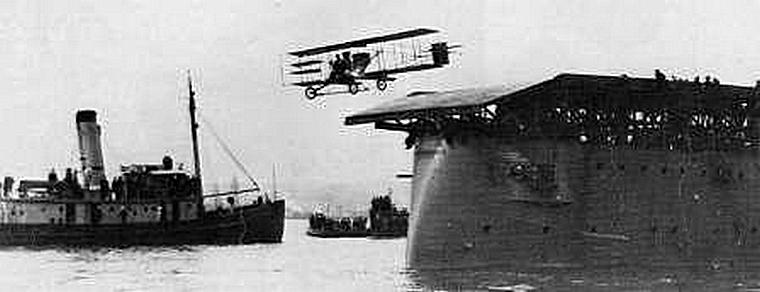First landing by an airplane on a ship
Eugene Burton Ely. Photo: Public Domain / commons.wikimedia.org Eugene Burton Ely (21 October 1886 - 19 October 1911) was an aviation pioneer, credited with the first shipboard aircraft take-off and landing. Ely graduated from Davenport Grammar School on 4 January 1901 and 1904 he found employement as a chauffeur for the Rev. Fr. Smyth, a Catholic priest in Cosgrove, Iowa. Smyth shared Ely's love of fast driving and he allowed Ely to use his red Franklin to set a speed record between Iowa City and Davenport.
In early 1910 Ely got a job as an auto salesman, working for E. Henry Wemme purchased one of Glenn Curtiss' first four-cylinder biplanes. Wemme was not a pilot and unable to fly the Curtiss. Ely, believing that flying was as easy as driving a car, offered to fly it. He ended up crashing it instead, and feeling responsible, bought the wreck from Wemme.

Curtiss Curtiss Model D "Pusher" was among the very first aircraft in the world to be built in any quantity. Photo: California State Military Museum
It took him a few months to repair the Curtiss and he then set about learning to fly it and 5 October 1910 he became the 7th person to be granted a pilot's license from the Aero Club of America. Soon afterwards he flew to Minneapolis to participate in an exhibition and met Curtiss who offered him a job.
At that stage the US Navy was investigating possible applications for aircraft in the Navy. Curtiss and Ely suggested the possibility that aircraft might be able to take off from a suitable platform on the deck of a naval vessel. The navy was interested and a temporary platform was constructed on the USS Birmingham. The Curtiss Pusher was hoisted on board and on 14 November 1910 Ely took off from the 83 feet long platform plunging towards to water below, its wheel dipping into the ocean. Ely, however, recovered and landed on a nearby beach.

Ely takes off from the USS Birmingham. Photo: US Naval Institute.
Two months later, on 11 January 1911, Ely landed the Curtiss pusher airplane on a platform on the USS Pennsylvania anchored in San Francisco Bay. This flight was also the first ever using a tail hook system, designed and built by circus performer and aviator Hugh Robinson. Ely told a reporter: "It was easy enough. I think the trick could be successfully turned nine times out of ten."
|
   |























